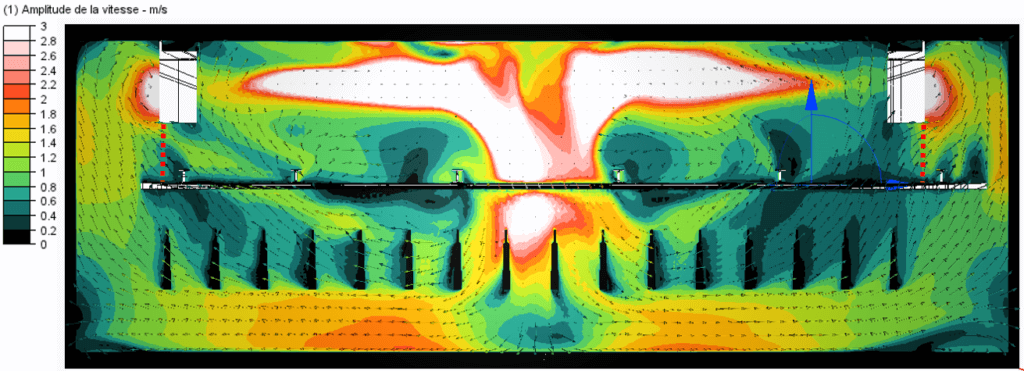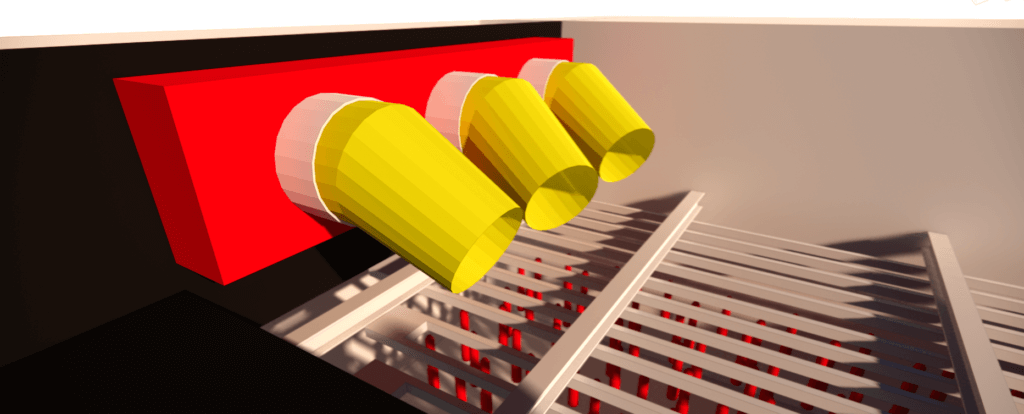Home » HVAC » Climatic engineering of high rise premises » Cold room – penetrant testing
Cold room – penetrant testing
Study of climatic conditions in a cold room
EOLIOS Engineering provided an overview of the climatic conditions in a cold penetrant room. The air mixing could be improved to promote the cooling of foodstuffs
Cold room - penetrant testing
Year
2021
Customer
Location
France
Typology
HVAC
Continue navigation :
Our other projects :
Latest news :
CFD simulation of a cold room
The objective of the study is to optimize the diffusion of air in a cold room.
The main purpose of cold rooms used in the meat industry is to place products in suitable temperature conditions and maintain them in an atmosphere where relative humidity will be favorable to both reducing weight loss and reducing microbial spoilage.
What are the climatic conditions in a penetrant testing cold room?
Penetrant testing is characterized by a massive evacuation of calories accompanied by slight evaporation. It aims to quickly lower the surface temperature of the carcasses, thus preventing the proliferation of germs and reducing the loss of water by evaporation. The ambient temperature is around 0° C. and the carcasses are kept there for between 4 and 6 hours.
The air has a double function: ensuring the mixing and conveying the cold. As a result, it is necessary to reconcile sufficient mixing to allow cooling and homogenization with fairly low air agitation to avoid too much water loss.
CFD simulation of a cold room
How to optimize the aeraulics of a cold room via CFD simulation?
The objective of this study is to study the diffusion of air in the volume so as to optimize the mixing of air in the pieces of meat in order to maintain the center of the meat at 4°C.
Proper refrigeration should enable a low core temperature of refrigerated foodstuffs to be obtained. It depends on the initial temperature of the foodstuff, its mass, the bleeding temperature, the storage temperature. This core temperature determines the shelf life. The good arrangement of the carcasses in the cold room allows a good ventilation and facilitates the penetration of the cold. The fact of having many shelves without carcasses, mainly in the axis can be unfavorable. Indeed, there is a risk of concentration of air flows in the empty rack axis. Lines of stored carcasses lead to greater air resistance, which will reduce the effectiveness of mixing in these areas, because the air will tend to concentrate in the empty areas.
The air movements in the room consist of two opposite loops driven by diffusion from the evaporator fans. These loops cause high speeds on a vertical axis in the central part of the room. They also cause high speeds at ground level . However inside the carcass zone, where the central zone of the recirculation loops is located, the air speeds are much lower.
Design of a palliative solution to obtain a regulation core temperature of meat
All the carcasses are not stirred at the same speed and the carcasses in the central zones of the loops end up insufficiently stirred. The fact that mixing is reduced results in the stagnation of calories on the surface of the carcasses, which reduces convective exchanges . On the other hand, the recirculation phenomena also lead to the looping of the calories in the low speed zones, which leads to a slight increase in the temperatures in these zones.
In the end, EOLIOS was able to design a custom-made system to improve the cooling conditions of foodstuffs in the cold room.
Continue on this topic
Video summary of the study
Discover other projects
Protected: Controlling comfort under a glass roof: CFD simulation of an atrium
Heating/Cooling system design for a pharmaceutical plant
Aquatic Center – Haut de Seine
Prototype – Natural ventilation chimney
HVAC – Medical equipment warehouse
Sharaan by Jean Nouvel resort
Swimming pool – Montreuil
Thermal comfort study – trichloramine diffusion in a children’s pool
Plant – Wind turbine
Cold Room – Leipzig
Cold room – penetrant testing
Palais Omnisports de Paris-Bercy
Sizing of natural draft extractor hoods





